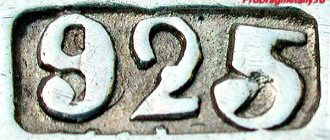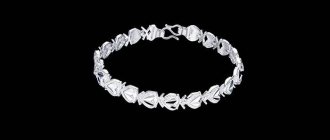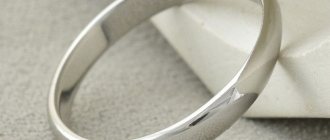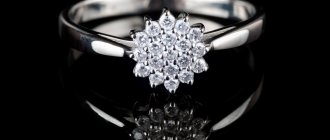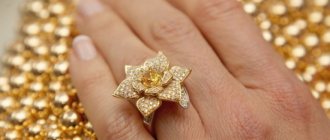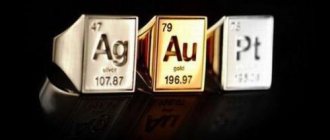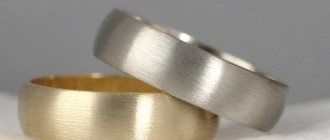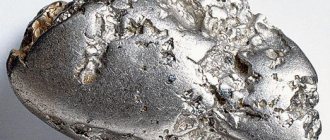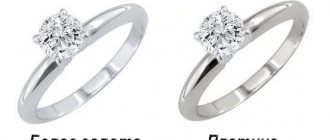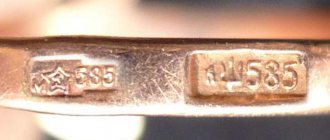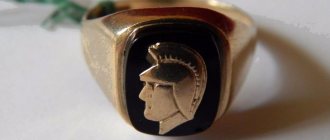White gold has a huge number of fans, and all because it has a noble and elegant look. This metal is used to make jewelry. This gold became popular among aristocrats almost 100 years ago. The metal perfectly emphasized the beauty of precious stones and pearls, which could not be said about red and yellow gold. Since then, white gold has been used to make jewelry: bracelets, earrings, chains, rings, including wedding rings. In most cases, white gold is mistakenly called platinum or a type of silver. In fact, white gold is an alloy, which, in addition to gold, includes other metals (ligature). To understand what this type of gold is, you should analyze its composition and assay characteristics.
Alloy composition
Gold in its pure form always has a yellow tint, so you cannot get white without impurities. White gold is not a specific type, but an alloy that can have different compositions. Nickel, platinum and palladium give it its characteristic color. They can be found in different proportions - the price of the product will depend on this.
Some people assume that white gold comes from the addition of silver, but in reality it is added very rarely and in small proportions. It dulls the decoration and deprives it of shine, which is considered a negative characteristic.
The combination of different elements in an alloy is called a master alloy. The composition of the white gold alloy may include the following metals:
- platinum;
- palladium;
- zinc;
- nickel;
- silver;
- bronze and others.
The most expensive alloy is made with platinum and palladium - only well-off people can purchase jewelry from it. But there are other, cheaper varieties - for example, with silver and nickel. However, you should wear such jewelry with caution: nickel may cause an allergic reaction. If the skin in contact with the metal becomes inflamed and red, it is best to discard this product or purchase a more expensive equivalent.
One of the most popular variations of white gold is 585. It includes the traditional 58.5% pure gold, and the remaining elements are copper (no more than 34%) and silver (no more than 7.5%). This alloy is practical because, thanks to the high content of precious metals, it does not fade over time, and copper gives it additional strength, which allows you to use the jewelry for many years.
It is a favorite material and highly prized, so it is not surprising that it is associated with wealth and costliness, although it does not always command a high price. This is also indicated by the famous paraphrase: in a figurative sense, cotton is usually called white gold, showing its value and significance.
Officially recognized chemical compositions of white gold
The interstate standard, described in GOST 6835–2002, clearly defines the proportions of officially accepted compounds of gold with other metals. There are only 37 of them. The table below shows only white gold compositions:
| Try | Gold, % | Platinum, % | Palladium, % | Nickel, % | Impurities, no more than % |
| 950 | 94,5–95,5 | — | — | Ost | 0,11 |
| 930 | 92,6–93,4 | 6,6–7,4 | — | — | 0,11 |
| 900 | 89,6–90,4 | 9,6–10,4 | — | — | 0,11 |
| 840 | 83,5–84,5 | — | 15,5–16,5 | — | 0,13 |
| 800 | 79,5–80,5 | — | 19,5–20,5 | — | 0,13 |
| 600 | 59,5–60,5 | — | 39,5–40,5 | — | 0,13 |
| 600 | 59,4–60,6 | 9,5–10,5 | 29,5–30,5 | — | 0,18 |
This classification is followed by 10 countries of the post-Soviet space:
- Armenia
- Belarus
- Kazakhstan
- Kyrgyzstan
- Moldova
- Russia
- Tajikistan
- Turkmenistan
- Uzbekistan
- Ukraine
Manufacturing process
White gold is made in two main ways. The more expensive alloy, obtained with the addition of platinum, does not require additional processing, so its manufacturing scheme is simple:
- In industrial conditions, pure gold is melted, which happens quickly, because its melting point is low.
- Then the ligature is prepared. Metals that will later be included in the alloy are carefully measured so that their content strictly corresponds to the standard. They are also melted and then mixed until a homogeneous mass is formed.
- The most difficult stage is the last one, where you need to mix the ligature and gold. In this case, all necessary conditions must be observed, otherwise the product will be of poor quality.
This is where the production of the expensive version ends, but with the cheap one everything is somewhat more complicated. It contains nickel, which not only can be an allergen, but also affects the color of the product in a negative way. Therefore, such jewelry is not produced in its natural form. As a rule, they are coated on top with rhodium, an extremely expensive metal that is part of the platinum group. This procedure is called rhodium plating.
After such treatment, the owner of the jewelry will not come into contact with nickel, but with rhodium, so allergies are excluded. Sometimes this metal is included in an alloy, then the coating is made of ruthenium, which is part of the same platinum group, but is more common and has a lower price.
However, rhodium-plated products have disadvantages, and the main one is the coating that gradually wears off. It is best not to wear them every day, putting them on only for the most special moments. This way the original look will last longer.
Various shades
Depending on the added metals and their proportions, white gold of different shades is obtained:
- to get the classic white color, an alloy of 14% palladium, 7% silver and 4% nickel is used, sometimes not irradiated;
- a high silver content - usually 25% - gives the product a green tint;
- to obtain an alloy with a yellow tint, 15% silver and 10% copper are added to it;
- a more saturated red color is given by a high copper content - 21% - with a lower proportion of silver - 4%;
- gold of an exotic bluish or black hue can be obtained using complex technological processes involving rhodium, which significantly increases the price of the final product.
There are a lot of variations, which allows you to combine them with various precious stones to create unique jewelry. However, the traditional white color is most valued.
Metal samples
When talking about the quality of jewelry, the standard of the metal from which it is made is usually mentioned, but not everyone understands what exactly this term means. The hallmark (or hallmark) shows the gold content of the alloy. The most common is 585, which contains 58.5% gold.
Since all high-quality products have a certain standard, it is easy to guess that nothing can be made from pure gold without impurities. This is true: although this metal is popular and highly valued, it is not so easy to work with. It is too soft and pliable and easily deformed even in everyday conditions. Therefore, jewelry made from it in its pure form would be fragile and short-lived.
There are many samples of gold , but here are the most famous ones, which are easy to find for sale in any jewelry store:
- 375 - due to the low content of gold itself (37.5%), products on which this sample is applied are considered the least valuable. They usually contain a considerable proportion of nickel, which can cause certain problems. There are other varieties of 375 standard, which use an alloy made of more precious metals. A definite advantage of such jewelry is their price: they are accessible to almost all segments of the population.
- 500 is a rare standard in which the gold part is exactly half. It is not often used for several reasons. Firstly, the high proportions of silver and copper included in the composition give the alloy shades that are not very pleasing to the eye. Secondly, the very structure of the material is such that it is difficult to work with. It will most likely not be possible to cast something cute and elegant out of it.
- 585 is the most commonly used grade with 58.5% gold. It has become so widespread due to the successful combination of a pleasant appearance and the possibility of long-term use.
- 750 is the highest standard for white gold and, accordingly, the most expensive. It contains 75% pure aurum, which makes such jewelry particularly fragile and vulnerable to any external influences. Those who acquire them should remember that they require careful care. This alloy is very highly valued and therefore is found in the collections of famous jewelry manufacturers: Bulgari, Tiffany and others.
Chemical compositions of white gold not included in the standard
Our fellow citizens purchase some of their jewelry abroad. In other countries, they adhere to different proportions when creating jewelry. As a result, the noble metal does not lose its properties. But owners may have difficulty selling such jewelry or obtaining a loan for them at a pawnshop. Below are the most common chemical compositions of white gold.
| Try | Gold, % | Silver, % | Palladium, % | Copper, % | Nickel, % | Zinc, % |
| 583 | 58,3 | 23,7 | 18,0 | — | — | — |
| 583 | 58,3 | — | — | 23,5 | 12,2 | 6,0 |
| 750 | 75 | 5 | — | — | 20 | — |
| 585 | 58,5 | 25,5 | — | — | 16,5 | — |
| 750 | 75 | 5 | 20 | — | — | — |
How to spot a fake
When purchasing expensive jewelry, you always want to be sure that white gold is the real material and not a cheap imitation. There are several simple ways to check what elements a piece of jewelry is made of.
The first thing to do is check the hallmark to see if it is present and looks right. However, this method is not the most effective these days, when it is not so difficult to fake markings. Even if it exists, it could well have been stamped using special equipment.
To understand whether sellers are selling cheaper silver for white gold, you need to take a closer look at it. Despite the admixtures of metals with cold undertones, the color of gold will still be overall warm. If nothing of the kind is noticeable and only cool shades are visible in the color scheme, most likely it is silver.
There is a more reliable way to check: run the product across a sheet of white paper. Silver jewelry will leave a noticeable mark on it, while gold jewelry will leave the sheet clean.
Another simple way to distinguish fake gold from real gold is to buy a lapis pencil at the pharmacy, moisten it in water and run it over the metal. If the alloy is genuine, there will be no traces left on it.
Real gold jewelry can be placed in vinegar for a while and it will not change in appearance, which cannot be said about a fake - its color will change.
Another chemical reaction that can be easily done at home requires the use of iodine. You need to drop a minimal amount of this substance onto the surface of the gold and wipe it off immediately. If the jewelry is genuine, it will look the same as before, but a small mark will remain on the fake one.
Finally, a method that does not always work in the modern world involves using a magnet. Precious metals are not attracted to it, so a reaction to it means there is an impurity in the composition. However, nickel, which is quite often used to create the alloy, reacts to a magnet. But still, its percentage is usually low, and the product should not be attracted quickly and strongly. If this happens, it is highly likely to be a fake.
Advantages and disadvantages
Whether it is worth buying products made from this metal and why, everyone will decide for themselves. But it is still necessary to note some features that can influence the choice in one direction or another.
Products made from precious metals delight their owners with unique properties that allow them to wear such jewelry for many years and even pass it on from generation to generation. If the alloy contains platinum, the advantages of use will be felt especially well, since both this metal and gold do not react with alkalis and acids. Thanks to this, the item will last a long time and will be slightly susceptible to corrosion.
In addition, this combination of metals has high strength and wear resistance. The owner will have little chance of scratching the jewelry , breaking off a piece from it, or otherwise mechanically damaging it. Water and air, which constantly affect jewelry, will also not have a significant effect on the condition of the jewelry.
But there are also disadvantages that you should remember when choosing. When buying a variation containing platinum, you will have to spend a lot of money, because such an alloy is even more expensive than regular gold. It is best to purchase such things in specialized jewelry stores designed for respectable clients, so as not to stumble upon a fake.
If the choice fell on a less expensive rhodium-plated product, it is worth remembering that the outer layer will thin out over time, and the type of decoration will change. This coating can always be updated by contacting a jeweler, but this will cost additional money.
Does gold spoil?
Many owners of white gold items wonder why gold takes on an unattractive yellow tint? A high-quality precious metal will not change its color or tarnish if it is properly cared for: at least once every two months, washed in soapy water and gently brushed. When working with household chemicals, you should protect jewelry from contact with it. It is worth considering that manual labor (cleaning, washing), contact of jewelry with aggressive detergents contribute to damage to the rhodium plating, which is why white gold appears to turn yellow. The thing is that rhodium, compared to white gold, has a lighter shade, so the violation of the integrity of the outer layer makes the difference between the shades of both metals noticeable.
The rhodium layer can be restored; to do this, just contact a jeweler. During the process, the worn layer of rhodium is removed and a new coating is applied in its place. If the product has high-quality rhodium plating, then it can be renewed at least once every 5–10 years.
You should purchase gold products in specialized stores, whose employees can demonstrate the necessary documentation for the product being offered. You should not buy jewelry second-hand, as there is a high risk of buying a fake.
Use Cases
White metal is so popular precisely because it has virtually no restrictions on its use. Jewelry made from it can be of any size and shape and still look great.
Earrings, rings, bracelets, necklaces, chains and other accessories of any complexity are made from it. It goes well with any precious stones, but diamonds or moonstone look especially elegant when framed with it.
Both men and women of any age can wear such jewelry. It is also suitable for small children who are just beginning to form their preferences. And if some more traditional options - for example, gold in the usual yellow shade - may become outdated over time , then the stylish white color will never go out of fashion.
What stones are suitable?
There are several stones that are invariably encrusted with jewelry made from this material. Most often, white gold is decorated with:
- diamonds;
- sapphires;
- emeralds;
- cubic zirconias.
Pairs perfectly with diamonds. The hint of gold helps give the stones color and shine. Jewelry inlaid with these stones looks very impressive. At the same time, the color of diamonds does not matter much. Jewelers use stones of any color and shade; black diamonds set in white gold look especially good.
Sapphires and emeralds also pair well with the shine of Au. The metal complements the natural shine of the stones and makes them more noticeable. In most cases, jewelers use large stones, so the cost of such jewelry is quite high.
Cubic zirconia can also be used as a supplement. These stones are used to decorate jewelry just like diamonds; naturally, the shine of such products is not as good, but the cost is quite reasonable.
Jewels are also inlaid with opal - the white color goes well with the color of the stone and complements its shine. Opal is one of those stones that is not very expensive, but can be used for inlaying white gold jewelry.
